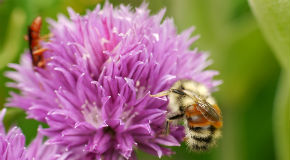 Support bees and butterflies
Support bees and butterflies

Bees and butterflies in the city rely on our gardens and green spaces for food and shelter.
In return, these beneficial insects pollinate our plants, crops, and fruit trees, giving us beautiful flowers, fruits, nuts, and honey.
But pollinators are disappearing due to growing cities, pesticide use, and the spread of diseases.
Five ways you can support pollinators in your garden
-
Include pollinator-friendly plants in your garden with long bloom times over spring and summer (see the plant list below). Choose a mix of plants that produce flowers of different shapes, sizes, and colours to attract many kinds of bees and butterflies. Even weeds like clover and dandelion are good. Try to add some native plants to encourage native bees.
-
Keep your garden pesticide-free.
-
Create nesting sites for bees. Buy or build a mason bee house of nesting tubes. Leave open, unmulched areas in your garden because over 70 per cent of native bees nest in dry soil below ground.
-
Start a boulevard or street garden of pollinator plants in your neighbourhood as part of the City’s Green Streets Program.
-
Take a course in sustainable gardening at VanDusen Botanical Garden.
-
Search and register for recreational programs
-
Plants that pollinators love
- Lavender (Lavendula)
- Rhododendron
- White Clover (Trifolium repens)
- Cotoneaster
- Heather (Calluna)
- Purple Toadflax (Linaria purpurea)
- California Lilac (Ceanothus)
- Bachelor’s Button (Centaurea)
- Bellflower (Campanula)
- Thyme (Thymus)
- Forget-Me-Not (Myosotis)
- Yellow Mustard (Brassica)
- Sage (Salvia)
- Escallonia
- Cranesbill (Geranium)
- Aster
- English Daisy (Bellis perennis)
- Rosemary (Rosmarinus)
- Mint (Mentha)
- Oregano (Origanum vulgare)
- Borage (Borago)
- Calendula
- Lily Of The Valley (Peleris)
- Shrubby Veronica (Hebe)
- Blackberry/Raspberry (Rubus)
